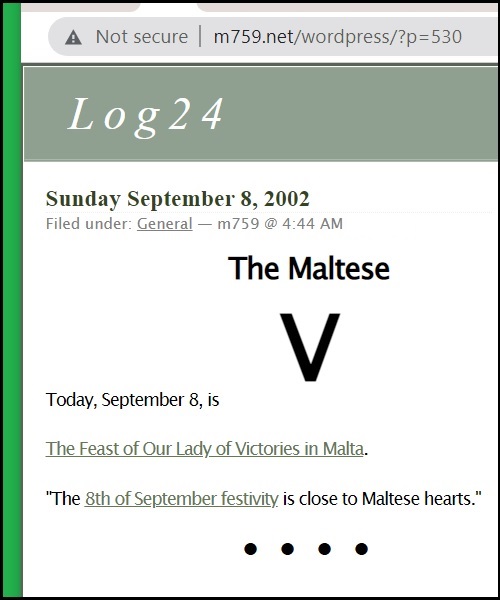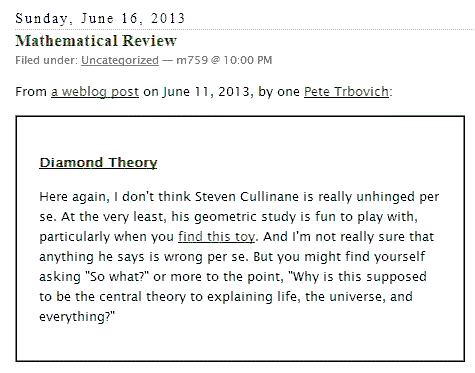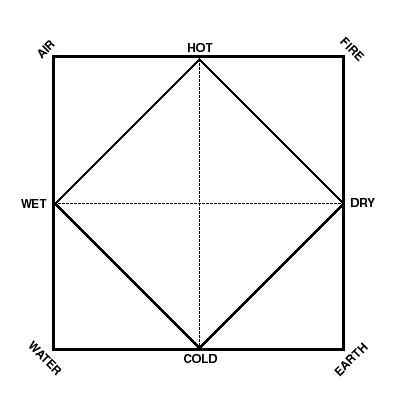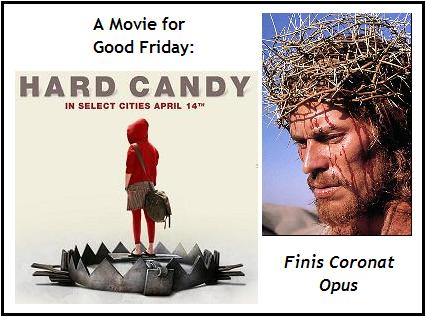Monday, September 26, 2022
A Chevron for Pynchon: The Maltese V
Tuesday, September 10, 2013
Kakutani on Pynchon
"A version of this review appears in print
on September 11, 2013,
on page C1 of the New York edition…."
Wednesday, March 6, 2013
Midnight in Pynchon*
"It is almost as though Pynchon wishes to
repeat the grand gesture of Joyce’s Ulysses…."
— Vladimir Tasic on Pynchon's Against the Day
Related material:
Tasic's Mathematics and the Roots of Postmodern Thought
and Michael Harris's "'Why Mathematics?' You Might Ask"
*See also Occupy Galois Space and Midnight in Dostoevsky.
Tuesday, January 30, 2024
For Harlan Kane: The Eigenspace Handle


|
From http://www.pynchon.pomona.edu/v/eigen.html — Perhaps history this century, thought Eigenvalue, is rippled with gathers in its fabric such that if we are situated, as Stencil seemed to be, at the bottom of a fold, it's impossible to determine warp, woof, or pattern anywhere else. By virtue, however, of existing in one gather it is assumed there are others, compartmented off into sinuous cycles each of which come to assume greater importance than the weave itself and destroy any continuity. Thus it is that we are charmed by funny looking automobiles of the '30's, the curious fashions of the '20's, the peculiar moral habits of our grandparents … We are accordingly lost to any sense of continuous tradition. Perhaps if we lived on a crest, things would be different. We could at least see. (Pp. 155-6, Harper Perennial ed.) |
Monday, April 24, 2023
The HexRoot Curse
(Title suggested by recent episodes of "The Blacklist.")
"It's the system that matters.
How the data arrange
themselves inside it."
The Pynchon quote is from posts now tagged Map Systems.
Saturday, March 25, 2023
Ice Medley
"Gabriel Ice is supposed to be an 'amiable geek'
whose greed and success as a tech entrepreneur
have turned him to the dark side, but it’s hard to
believe that this kid billionaire and his wife would
choose to live in 'deep hairband country' on the
Upper East Side, in a grand dwelling boasting a
Bösendorfer Imperial in the corner of one of its
public rooms, 'at which generations of hired piano
players have provided hours of Kander & Ebb,
Rodgers & Hammerstein, Andrew Lloyd Webber
medleys.' "
— Michiko Kakutani,
review of Pynchon's Bleeding Edge
Related Internet material —

See also LARB on Pynchon's fictional DeepArcher program.
Tuesday, March 2, 2021
McLuhan and the Time Machine
Page 1590 —
Log24:
Thomas Pynchon:
"For every kind of vampire,
there is a kind of cross."
The Year 1591 —

Sunday, December 27, 2020
V
From today’s post “Logo Animation” —
Related material from the art world —
Related entertainment —
“V. is whatever lights you to the end of the street: she is also the dark annihilation waiting at the end of the street.” (Tony Tanner, page 36, "V. and V-2," in Pynchon: A Collection of Critical Essays, ed. Edward Mendelson. Prentice-Hall, 1978. 16-55). |
Midrash — Other posts tagged Annihilation.
Monday, October 26, 2020
Theory

These news items suggest a review —
The above “Pynchon’s Paranoid History” page number appeared
in this journal on Groundhog Day, 2015 —
David Justice on a Zeta-related theory —
Wednesday, July 22, 2020
Logo
The Project Voldemort logo capture shown below is the first one at archive.org.
It is dated Dec. 23, 2009. See also this journal on that date —
“V. is whatever lights you to the end of the street: she is also the dark annihilation waiting at the end of the street.” (Tony Tanner, page 36, "V. and V-2," in Pynchon: A Collection of Critical Essays, ed. Edward Mendelson. Prentice-Hall, 1978. 16-55). |
Wednesday, June 10, 2020
Space X File
"For every kind of vampire,
there is a kind of cross."
— Thomas Pynchon, Gravity's Rainbow
"Sometimes I hit London."
— Saying ascribed to Wernher von Braun
Inscribed Carpenter's Square:

In Latin, NORMA
Friday, January 10, 2020
Jan. 9 Review
“Work as if you were in the
early days of a better nation.”
— God, according to the author of
1982 Janine
|
From Carole A. Holdsworth, Tanner may have stated it best:
“V. is whatever lights you to
(Tony Tanner, page 36,
She’s a mystery |
Tuesday, May 28, 2019
Quaternion at Candlebrow
From a Groundhog Day post in 2009 —
|
The Candlebrow Conference The conferees had gathered here from all around the world…. Their spirits all one way or another invested in, invested by, the siegecraft of Time and its mysteries. "Fact is, our system of so-called linear time is based on a circular or, if you like, periodic phenomenon– the earth's own spin. Everything spins, up to and including, probably, the whole universe. So we can look to the prairie, the darkening sky, the birthing of a funnel-cloud to see in its vortex the fundamental structure of everything–" "Um, Professor–"…. … Those in attendance, some at quite high speed, had begun to disperse, the briefest of glances at the sky sufficing to explain why. As if the professor had lectured it into being, there now swung from the swollen and light-pulsing clouds to the west a classic prairie "twister"…. … In the storm cellar, over semiliquid coffee and farmhouse crullers left from the last twister, they got back to the topic of periodic functions…. "Eternal Return, just to begin with. If we may construct such functions in the abstract, then so must it be possible to construct more secular, more physical expressions." "Build a time machine." "Not the way I would have put it, but if you like, fine." Vectorists and Quaternionists in attendance reminded everybody of the function they had recently worked up…. "We thus enter the whirlwind. It becomes the very essence of a refashioned life, providing the axes to which everything will be referred. Time no long 'passes,' with a linear velocity, but 'returns,' with an angular one…. We are returned to ourselves eternally, or, if you like, timelessly." "Born again!" exclaimed a Christer in the gathering, as if suddenly enlightened. Above, the devastation had begun. |
"As if the professor had lectured it into being . . . ."
See other posts now tagged McLuhan Time.
Tuesday, January 15, 2019
Paragraph 13
Related material —
The recent post "For Captain Midnight and the Whole Sick Crew"
and an illustration from the Log24 link in yesterday's post "Searching" —
Thursday, July 27, 2017
Keeping It Simple
Michiko Kakutani in The New York Times —
"The detective story genre concerns the finding of clues
and the search for hidden designs, and its very form
underscores Mr. Pynchon’s obsession with conspiracies
and the existence of systems too complicated to understand."
— Review of Pynchon's Bleeding Edge , Sept. 10, 2013
Background: "Moss on the Wall," this journal on that date.
A less complicated system —
"Plan 9 deals with the resurrection of the dead."
— Bill Murray in "Ed Wood"
(The plan , as well as the elevation ,
of the above structure is a 3×3 grid.)
Tuesday, February 7, 2017
Wednesday, May 4, 2016
Hail Affleck
Random thoughts suggested by the reference in the
previous post to Aegean Park Press and to stencils —
"Stencil’s entire existence is focused on the hunt for V.,
a classic novelistic quest-without-resolution (in fact, V.
might be fiction’s greatest example of a MacGuffin). V.
may be a person, or may be a place, though it could
also be neither: Pynchon calls it, at one point,
'a remarkably scattered concept' and, at another,
'the ultimate Plot Which Has No Name.' "
— Alexander Nazaryan in The New Yorker ,
article dated March 29, 2013
How about a date ?
From this journal on Good Friday, March 29, 2013 —
Thursday, April 16, 2015
Forms of Luminosity
"Visibilities are not forms of objects, nor even forms
that would show up under light, but rather forms of
luminosity which are created by the light itself and
allow a thing or object to exist only as a flash, sparkle
or shimmer."
— Deleuze, Foucault
Clap if you believe in Plotnitsky .
From his "Teaching" page —
| Capitalism and Paranoia, Capitalism and Schizophrenia: Foucault, Deleuze, and Modernist Novel. The course offers a comprehensive examination of the works of Michel Foucault and Gilles Deleuze, and of the relationships between their ideas and the culture of modernity and, then, postmodernity, as the culture of capitalism. The course also considers, through the optics of Foucault's and Deleuze's work, how this culture is reflected in modernist and postmodernist novels of the twentieth century, and in the genre of the novel itself, which has been the dominant and indeed defining literary genre of this culture, from early to late capitalism. While Foucault's and Deleuze's work may be seen as a radical philosophical critique of modernity and capitalism by the philosophical means, the novel enacts an analogous and often equally radical literary critique. The works to be discussed include selections from Marx, Nietzsche, and Freud; Foucault's The Order of Things, Discipline and Punish, History of Sexuality, vol.1, and selected essays; and substantive selections from such works by Deleuze (and Deleuze and Guattari) as Anti-Oedipus, A Thousand Plateaus, and Foucault, as well as several shorter essays. Among the works of fiction to be considered are Joyce's A Portrait of the Artist as a Young Man; Kafka's The Trial; Woolf's Orlando; and Pynchon's The Crying of Lot 49. |
Thursday, February 27, 2014
Secular Space
This morning's previous post, on sacred space,
linked to "Positively White Cube Revisited,"
an article by one Simon Sheikh.
Sheikh writes well, but he seems to be a disciple
of the damned Marxist lunatic Louis Althusser.
As Pynchon put it in Gravity's Rainbow ,
"For every kind of vampire, there is a kind of cross."
In this case, a video starring Sheikh on the exhibition "All That Fits"
suggests, by its filming date (May 27, 2011), a Maltese cross.
"The stuff that dreams are made of." — Bogart
(See also Oct. 25, 2012.)
Sunday, December 8, 2013
Honors Night
Tonight was Honors Night at the Kennedy Center.
"For every kind of vampire,
there is a kind of cross." — Pynchon
|
From "Colin Wilson: The Persistence of Meaning" "At a literary conference at SUNY New Paltz three years ago, among people who I thought would be positively disposed to Wilson, my mentioning of his name resulted in any number of arched eyebrows and suavely disparaging remarks. Now this might itself be, not an affirmation of justified oblivion, as one could easily assume, but rather a kind of indirect evidence for intrinsic merit. I stress the academic character of the event and the self-assured oiliness of the dismissal. In context, the reference seemed to carry a distinctly un-PC valence so that the reaction to it, as I picture it in retrospect, resembled that of a patrician vampire to garlic."
— Thomas F. Bertonneau on Thursday, |
Saturday, September 14, 2013
Where Entertainment Is God
"Motifs bleed off the edge of one Pynchon canvas
onto the next." — Review of Bleeding Edge in
tomorrow's New York Times Sunday Book Review
A RIDDLE for the Church of St. Frank:

AN ANSWER:

The red carpet is prepared for the 2013 Oscars at the Dolby Theatre.
Tuesday, July 9, 2013
Plan 9
Related material from June 3, 2008 …
On Faith:
“God is the original conspiracy theory….
Among the varieties of Christian monotheism,
none is more totalitarian, none lodges more radical
claims for God’s omnipotence, than Calvinism—
and within America, the chief analogue of Calvinist
theology, Puritanism. According to Calvin every
particle of dust, every act, every thought, every
creature is governed by the will of God, and yields
clues to the divine plan.”
– Scott Sanders, “Pynchon’s Paranoid History“
Sunday, June 30, 2013
Book Award
|
"What on earth is
— Said to be an annotation |
In the spirit of the late Thomas Guinzburg…
See also "Concrete Universal" in this journal.
Related material— From a Bloomsday reply
to a Diamond Theory reader's comment, an excerpt—
The reader's comment suggests the following passages from
the book by Stirling quoted above—
Here Stirling plays a role analogous to that of Professor Irwin Corey
accepting the National Book Award for Gravity's Rainbow in 1974.
Monday, February 25, 2013
Off the Road
Thursday, February 21, 2013
Galois Space
The previous post suggests two sayings:
"There is such a thing as a Galois space."
— Adapted from Madeleine L'Engle
"For every kind of vampire, there is a kind of cross."
Illustrations—
Friday, December 28, 2012
Cube Koan
|
From Don DeLillo's novel Point Omega — I knew what he was, or what he was supposed to be, a defense intellectual, without the usual credentials, and when I used the term it made him tense his jaw with a proud longing for the early weeks and months, before he began to understand that he was occupying an empty seat. "There were times when no map existed to match the reality we were trying to create." "What reality?" "This is something we do with every eyeblink. Human perception is a saga of created reality. But we were devising entities beyond the agreed-upon limits of recognition or interpretation. Lying is necessary. The state has to lie. There is no lie in war or in preparation for war that can't be defended. We went beyond this. We tried to create new realities overnight, careful sets of words that resemble advertising slogans in memorability and repeatability. These were words that would yield pictures eventually and then become three-dimensional. The reality stands, it walks, it squats. Except when it doesn't." He didn't smoke but his voice had a sandlike texture, maybe just raspy with age, sometimes slipping inward, becoming nearly inaudible. We sat for some time. He was slouched in the middle of the sofa, looking off toward some point in a high corner of the room. He had scotch and water in a coffee mug secured to his midsection. Finally he said, "Haiku." I nodded thoughtfully, idiotically, a slow series of gestures meant to indicate that I understood completely. "Haiku means nothing beyond what it is. A pond in summer, a leaf in the wind. It's human consciousness located in nature. It's the answer to everything in a set number of lines, a prescribed syllable count. I wanted a haiku war," he said. "I wanted a war in three lines. This was not a matter of force levels or logistics. What I wanted was a set of ideas linked to transient things. This is the soul of haiku. Bare everything to plain sight. See what's there. Things in war are transient. See what's there and then be prepared to watch it disappear." |
What's there—

This view of a die's faces 3, 6, and 5, in counter-
clockwise order (see previous post) suggests a way
of labeling the eight corners of a die (or cube):
123, 135, 142, 154, 246, 263, 365, 456.
Here opposite faces of the die sum to 7, and the
three faces meeting at each corner are listed
in counter-clockwise order. (This corresponds
to a labeling of one of MacMahon's* 30 colored cubes.)
A similar vertex-labeling may be used in describing
the automorphisms of the order-8 quaternion group.
For a more literary approach to quaternions, see
Pynchon's novel Against the Day .
* From Peter J. Cameron's weblog:
"The big name associated with this is Major MacMahon,
an associate of Hardy, Littlewood and Ramanujan,
of whom Robert Kanigel said,
His expertise lay in combinatorics, a sort of
glorified dice-throwing, and in it he had made
contributions original enough to be named
a Fellow of the Royal Society.
Glorified dice-throwing, indeed…"
Friday, December 7, 2012
The Embedding
( Continued from December 6th — and from Duelle here and in Pynchon )
Part I
The Galois Embedding
Part II
Tuesday, October 2, 2012
Red October
"In the master's bedroom, they gathered for the feast…."
— Suggested by the current film Hotel Transylvania
"For every kind of vampire, there is a kind of cross."
– Thomas Pynchon, Gravity's Rainbow
Related material— the Feast of Saint Patrick in 2009.
Friday, September 21, 2012
Trouble with the Curve
The Harvard Crimson on last night's Ig Nobel Prize ceremony:
"The theme of the evening was 'The Universe,' a catchword
that had the audience cheering any time it was mentioned
throughout the night. Throughout the ceremony, a mini opera
entitled 'The Intelligent Designer and the Universe'* premiered
in four acts.
The opera’s final line was “This is how the Universe decays
into insanity.”
* An opera "about an insane wealthy man who bequeaths his
fortune to have someone design a beautiful dress for the
universe." —Mark Pratt, Associated Press
In related news…
"Most mysteries begin in confusion and end in certainty;
Pynchon likes to change this trajectory, so that what begins
a mystery ends as pure chaos. (Well aware how frustrating
some readers find this, Pynchon sets up a running gag in
Inherent Vice about a class action suit brought against MGM
by audiences who don't like the way its stories end.)"
— Sarah Churchwell in The Guardian , Sunday, July 26, 2009
Sunday, June 26, 2011
Gloomy Sunday
This evening's NY Lottery numbers were 531 and 8372.
Hermeneutics—
From a Google search for "531 Log24"—
| Log24 on Sunday, Sept. 21, 2008
531 , Revelation without belief 116. Evening (Belief), Belief without… The date, 5/24, of the entries linked to in Thursday's noon Log24 entry… Pynchon on Quaternions – Log24 8. on Page 531 : "… to imps of ingenious discomfort. "Is this a stag affair, or are there likely to be one or two lady Quaternion- ists?…" |
The "531" linked to in the Sept. 21, 2008, post above is a mini-drama ending at midnight on 5/31, 2008— the conclusion of Mental Health Month.
And the above 4-digit evening number suggests a search for births on 8/3/72 that yields—
Erika Marozsán, Hungarian actress, 38.
Marozsán starred in "Gloomy Sunday—A Song of Love and Death" (A German/Hungarian film from 1999).
Wikipedia informs us that this "is inaccurately claimed to be the world's longest running film."
Whether Marozsán is a Quaternionist, I do not know.
For love, death, and quaternions, see the post Metaphor from Feb. 22 linked to in this afternoon's Sunday Dinner.
Sunday, May 29, 2011
A Mathematical Operation

New York Lottery, May 28, 2011—

General Boulanger
That the General was 'reactionary' and that the C of C bureaucracy had a 'defiant residue' of Boulangism, continues the characterization of the organization for which the Chums 'work'.
See p. 543 above, regarding a 2007 book in which Boulanger is called the 'father of fascism'.
timbres fictifs
French: fictive postage stamps. Cf "Lot 49".
Yes, stamps mean something in Pynchon's works; here, it seems important that these stamps are characterized as frauds.
transform
A mathematical operation that "maps" a relation from one domain to another.
Here, "Belgian Congo" maps to "Balkan Penninsula". By 1912, everyone at Yz-le-Bans would be familiar with Conrad's Heart of Darkness , if not with other descriptions of the atrocities of exploitation of indigenous people in Congo. The conversation here and to follow describes the dawning realization of the imperialist exploitation of Eastern Europe by European powers. (Zora Neale Hurston famously commented that Hitler did in Europe what Europeans had been doing in Africa for a century. Cf. The Hereros sections in V .). It begins with railroads and "other straight line" constructions.
The themes of ATD might also "map" to current events in another warzone, where a contemporary Great Game is being played out.
common in dreams
Such as Frank's and Reef's. And/or, dreams require interpretation.
Monday, May 23, 2011
Trajectory
This morning's previous post quoted a reader on the NY Times "Stoner" series. A different Stoner story—
"Most mysteries begin in confusion and end in certainty; Pynchon likes to change this trajectory, so that what begins a mystery ends as pure chaos. (Well aware how frustrating some readers find this, Pynchon sets up a running gag in Inherent Vice about a class action suit brought against MGM by audiences who don't like the way its stories end.)"
— Sarah Churchwell in the Guardian , Sunday, July 26, 2009
For a pure-chaos ending that can't be blamed on MGM, see this morning's online New York Times .
A perhaps happier ending— That of the author of the Irish Wine trilogy, Dick Wimmer, who died on Wednesday. We may imagine Wimmer enjoying the afterlife with Bing and Grace. See Log24 on the date of the above Guardian review.
Monday, April 18, 2011
Romancing the Junction

From Thomas Pynchon's 1997 Introduction to Stone Junction—
"He takes the Diamond, and then the Diamond takes him. For it turns out to be a gateway to elsewhere, and Daniel's life's tale an account of the incarnation of a god, not the usual sort that ends up bringing aid and comfort to earthly powers, but that favorite of writers, the incorruptible wiseguy known to anthropologists as the Trickster, to working alchemists as Hermes, to card-players everywhere as the Joker. We don't learn this till the end of the story, by which point, knowing Daniel as we've come to, we are free to take it literally as a real transfiguration, or as a metaphor of spiritual enlightenment, or as a description of Daniel's unusually exalted state of mind as he prepares to cross, forever, the stone junction between Above and Below— by this point, all of these possibilities have become equally true, for we have been along on one of those indispensable literary journeys, taken nearly as far as Daniel— though it is for him to slip along across the last borderline, into what Wittgenstein once supposed cannot be spoken of, and upon which, as Eliphaz Levi advised us— after 'To know, to will, to dare' as the last and greatest of the rules of Magic— we must keep silent."
"The devil likes metamorphoses." —The Club Dumas
Sunday, January 16, 2011
The Mind Spider*
On a conference at the New School for Social Research on Friday and Saturday, December 3rd and 4th, 2010—
"This conference is part of the early stages in the formation of a lexicon of political concepts. It will be the 5th in a series of conferences started in Tel Aviv University. The project is guided by one formal principle: we pose the Socratic question "what is x?", and by one theatrical principle: the concepts defined should be relevant to political thought…."
[The conference is not unrelated to the New York Times philosophy series "The Stone." Connoisseurs of coincidence— or, as Pynchon would have it, "chums of chance"— may read the conclusion of this series, titled "Stoned," in the light of the death on December 26th (St. Stephen's Day) of Matthew Lipman, creator of the "philosophy for children" movement. Many New York Times readers will, of course, be ignorant of the death by stoning of St. Stephen
Beloit College Nuremberg Chronicle
commemorated on December 26th. They should study Acts of the Apostles— Chapter 6 and Chapter 7.]
Meanwhile, in this journal—

For some background on the Dec. 4th link to "Damnation Morning," see "Why Me?"
For some political background, see "Bright Star"+"Dark Lady" in this journal.
* The title refers to a story by Fritz Leiber.
Saturday, January 8, 2011
True Grid (continued)
"Rosetta Stone" as a Metaphor
in Mathematical Narratives
For some backgound, see Mathematics and Narrative from 2005.
Yesterday's posts on mathematics and narrative discussed some properties
of the 3×3 grid (also known as the ninefold square ).
For some other properties, see (at the college-undergraduate, or MAA, level)–
Ezra Brown, 2001, "Magic Squares, Finite Planes, and Points of Inflection on Elliptic Curves."
His conclusion:
When you are done, you will be able to arrange the points into [a] 3×3 magic square,
which resembles the one in the book [5] I was reading on elliptic curves….
This result ties together threads from finite geometry, recreational mathematics,
combinatorics, calculus, algebra, and number theory. Quite a feat!
5. Viktor Prasolov and Yuri Solvyev, Elliptic Functions and Elliptic Integrals ,
American Mathematical Society, 1997.
Brown fails to give an important clue to the historical background of this topic —
the word Hessian . (See, however, this word in the book on elliptic functions that he cites.)
Investigation of this word yields a related essay at the graduate-student, or AMS, level–
Igor Dolgachev and Michela Artebani, 2009, "The Hesse Pencil of Plane Cubic Curves ."
From the Dolgachev-Artebani introduction–
In this paper we discuss some old and new results about the widely known Hesse
configuration of 9 points and 12 lines in the projective plane P2(k ): each point lies
on 4 lines and each line contains 3 points, giving an abstract configuration (123, 94).
PlanetMath.org on the Hesse configuration—

A picture of the Hesse configuration–

(See Visualizing GL(2,p), a note from 1985).
Related notes from this journal —
From last November —
|
From the December 2010 American Mathematical Society Notices—
Related material from this journal— Consolation Prize (August 19, 2010) |
From 2006 —
|
Sunday December 10, 2006
“Function defined form, expressed in a pure geometry
– J. G. Ballard on Modernism
“The greatest obstacle to discovery is not ignorance –
— Daniel J. Boorstin, |
Also from 2006 —
|
Sunday November 26, 2006
Rosalind Krauss "If we open any tract– Plastic Art and Pure Plastic Art or The Non-Objective World , for instance– we will find that Mondrian and Malevich are not discussing canvas or pigment or graphite or any other form of matter. They are talking about Being or Mind or Spirit. From their point of view, the grid is a staircase to the Universal, and they are not interested in what happens below in the Concrete. Or, to take a more up-to-date example…."
"He was looking at the nine engravings and at the circle,
"And it's whispered that soon if we all call the tune
The nine engravings of The Club Dumas
An example of the universal*– or, according to Krauss,
"This is the garden of Apollo, the field of Reason…."
For more on the field of reason, see
A reasonable set of "strange correspondences" Unreason is, of course, more popular. * The ninefold square is perhaps a "concrete universal" in the sense of Hegel: "Two determinations found in all philosophy are the concretion of the Idea and the presence of the spirit in the same; my content must at the same time be something concrete, present. This concrete was termed Reason, and for it the more noble of those men contended with the greatest enthusiasm and warmth. Thought was raised like a standard among the nations, liberty of conviction and of conscience in me. They said to mankind, 'In this sign thou shalt conquer,' for they had before their eyes what had been done in the name of the cross alone, what had been made a matter of faith and law and religion– they saw how the sign of the cross had been degraded."
– Hegel, Lectures on the History of Philosophy ,
"For every kind of vampire, |
And from last October —
|
Friday, October 8, 2010
Starting Out in the Evening This post was suggested by last evening's post on mathematics and narrative and by Michiko Kakutani on Vargas Llosa in this morning's New York Times .
"One must proceed cautiously, for this road— of truth and falsehood in the realm of fiction— is riddled with traps and any enticing oasis is usually a mirage."
– "Is Fiction the Art of Lying?"* by Mario Vargas Llosa,
* The Web version's title has a misprint— |
Thursday, January 6, 2011
Epiphany Riddle
"Spaces and geometries, those which we perceive,
which we can’t perceive, or which only some of us perceive,
are a recurring theme in Against the Day ."
"大哉大哉 宇宙之谜
美哉美哉 真理之源"
"Great indeed is the riddle of the universe.
Beautiful indeed is the source of truth."
— Shing-Tung Yau, Chairman,
Department of Mathematics, Harvard University
"Always keep a diamond in your mind."
— King Solomon at the Paradiso
Image from stoneship.org
Wednesday, November 10, 2010
Scavenger Hunt
A description in Pynchon's Against the Day of William Rowan Hamilton's October 16th, 1843, discovery of quaterions—
"The moment, of course, is timeless. No beginning, no end, no duration, the light in eternal descent, not the result of conscious thought but fallen onto Hamilton, if not from some Divine source then at least when the watchdogs of Victorian pessimism were sleeping too soundly to sense, much less frighten off, the watchful scavengers of Epiphany."
New York Lottery yesterday, on Hermann Weyl's birthday— Midday 106, Evening 865.
Here 106 suggests 1/06, the date of Epiphany, and 865 turns out to be the title number of Weyl's Symmetry at Princeton University Press—
http://press.princeton.edu/titles/865.html.
Symmetry and quaternions are, of course, closely related.
Friday, November 5, 2010
V Day for Natalie
This morning's post mentioned the new film "Black Swan," starring Natalie Portman, that opens December 3.
Portman also starred in the 2006 film "V for Vendetta," based very loosely on today's date— November 5, Guy Fawkes Day.
Some background on Alan Moore, the creator of the graphic novel underlying that film—
1. The New York Times , March 12, 2006
2. Panelling Parallax: The Fearful Symmetry of William Blake and Alan Moore
3. This journal on March 24, 2009
Also from March 24, 2009— An image for what Thomas Pynchon, in this morning's post, called "the watchful scavengers of Epiphany."
Seize the Day*
From last night's post—
"… right now…. winning the day…."
— President Obama on the 16th of October (between 5:19 and 5:37 PM EDT)
This journal on the 16th of October—
Saturday, October 16, 2010Quaternion DayBrightness at Noon continued – Sir William Rowan Hamilton, Oct. 16, 1843 See also this journal on 1/09, 2010. |
Related religious material from Thomas Pynchon—

* Material related to this post's title, "Seize the Day"—
Indirectly related — an ad for the new film Black Swan
accompanying a Halloween story in yesterday's online New York Times —
More directly related —
Black Swan Theory at Wikipedia —
Tuesday, June 1, 2010
Contra Harvard
Today is commencement day at Princeton.
Sunday's A Post for Galois was suggested, in part, by the fact that the founder and CEO of Amazon.com was that day's Princeton baccalaureate speaker. The Galois post linked to the Amazon reviews of one Christopher G. Robinson, a resident of Cambridge, Mass., whose Amazon book list titled "Step Right Up!" reflects a continuing libertine tradition at Harvard.
For Princeton's commencement day, it seems fitting to cite another Amazon document that reflects the more conservative values of that university.
I recommend the review Postmodern Pythagoras, by Matthew Milliner. Milliner is, in his own words, "an art history Ph.D. candidate at Princeton University."
See also Milliner's other reviews at Amazon.com.
"For every kind of libertine,
there is a kind of cross."
— Saying adapted from Pynchon
Tuesday, February 2, 2010
Time After Time
Godmother and Cinderella

Meryl Streep and Amy Adams in "Julie & Julia"
The image is from gossipsauce.com on August 2, 2009.
For a darker Godmother/Cinderella pair,
see the film discussed in this journal
on that same date (Lughnasa 2009).
A thought from Pynchon's Against the Day quoted here on Groundhog Day a year ago today—
“We thus enter the whirlwind. It becomes the very essence of a refashioned life, providing the axes to which everything will be referred. Time no long ‘passes,’ with a linear velocity, but ‘returns,’ with an angular one…. We are returned to ourselves eternally, or, if you like, timelessly.”
“Born again!” exclaimed a Christer in the gathering, as if suddenly enlightened.
Sunday, November 1, 2009
October Endgame
Suggested by the New York State lottery numbers on All Hallows' Eve–
430 (mid-day) and 168 (evening)…
From 430 as a date, 4/30— Beyond Grief and Nothing: A Reading of Don DeLillo, by Joseph Dewey, University of South Carolina Press, 2006, page 123:
"It is as if DeLillo himself had moved to an endgame…."
For such an endgame, see yesterday's link to a Mira Sorvino drama. The number 168 suggested by the Halloween lottery deals with the properties of space itself and requires a more detailed exegesis… For the full picture, consider the Log24 entries of Feb. 16-28 this year, esp. the entries of Feb. 27 and the phrase they suggest–
Flores, Flores para los muertos.
Consider also Xinhua today, with its discussion of rocket science and seal-cutting:
Click image for context.
For space technology, see the above link to Feb. 16-28 this year as well as the following (click on image for details)–
As for seal-cutting, see the following seal from a Korean Christian site:

See Mizian Translation Service for some background on the seal's designer.
Tuesday, August 4, 2009
Tuesday August 4, 2009
Just What We Need
Thomas Pynchon's new novel
Inherent Vice comes out today.
Title of a review in
The New York Times:
Another Doorway to the
Paranoid Pynchon Dimension
More interesting doorways:

An Aleph for Pynchon (July 9)
Click on the doorway for details.
|
|
The Aleph (July 8)
Click on the aleph for details.
Thursday, July 9, 2009
Thursday July 9, 2009
An Aleph for Pynchon
Part I:
A California Sixties version
of Heaven’s Gate:
Aleph Sanctuary, by Mati Klarwein
Part II:
Log24 entries of April 29, 2009
(esp. the link to Anastasia Ashley)
Part III:
Inherent Vice,
a novel by Thomas Pynchon
to be published in August 2009
Tuesday, June 16, 2009
Tuesday June 16, 2009
"Actualmente Maju estudia Publicidad en la Universidad de Ciencias Aplicadas de Lima, es modelo de la agencia Elite Model Management y viaja por varios paises realizando campañas de publicidad, y es imagen publicitaria exclusiva de varias empresas en su país."
Related material: "His and Hers: Something" (Log24 entry last year for the anniversary of the births of John Calvin and of Maria Julia Mantilla.)
“V. is whatever lights you to the end of the street: she is also the dark annihilation waiting at the end of the street.” (Tony Tanner, page 36, "V. and V-2," in Pynchon: A Collection of Critical Essays, ed. Edward Mendelson. Prentice-Hall, 1978. 16-55). |
Sunday, June 14, 2009
Sunday June 14, 2009
go to… Thomas Pynchon!
“For every kind of vampire,
there is a kind of cross.”
— Pynchon
Saturday, April 25, 2009
Saturday April 25, 2009
for both
Mathematics and Autism.
Welcome to the
Black Hole Café
"Our lifelong friendship made me not only an admirer of the depth, scholarship, and sheer energy of his mathematical work (and of his ceaseless activities as an editorial entrepreneur on behalf of mathematics) but one in awe of his status as the ultimate relaxed sophisticate."
|
Psychoshop
by Alfred Bester
|
it will be hard to uphold
the Glasperlenspiel
view of mathematics."
— Gian-Carlo Rota
"For every kind of vampire,
there is a kind of cross."
— Thomas Pynchon

Wednesday, April 8, 2009
Wednesday April 8, 2009
Is God
“For every kind of vampire,
there is a kind of cross.”
— Thomas Pynchon in
Gravity’s Rainbow
“Since 1963, when Pynchon’s first novel, V., came out, the writer– widely considered America’s most important novelist since World War II– has become an almost mythical figure,
— Nancy Jo Sales in the November 11, 1996, issue of New York Magazine
(Click on images for their
source in past entries.)
In a Nutshell:
“Plato’s Ghost evokes Yeats’s lament that any claim to worldly perfection inevitably is proven wrong by the philosopher’s ghost….”
— Princeton University Press on Plato’s Ghost: The Modernist Transformation of Mathematics (by Jeremy Gray, September 2008)
|
Tuesday, March 17, 2009
Tuesday March 17, 2009

The Square of Oppositon
at Stanford Encylopedia of Philosophy

The Square of Opposition
in its original form
"The diagram above is from a ninth century manuscript of Apuleius' commentary on Aristotle's Perihermaneias, probably one of the oldest surviving pictures of the square."
— Edward Buckner at The Logic Museum
From the webpage "Semiotics for Beginners: Paradigmatic Analysis," by Daniel Chandler:

The Semiotic Square
"The structuralist semiotician Algirdas Greimas introduced the semiotic square (which he adapted from the 'logical square' of scholastic philosophy) as a means of analysing paired concepts more fully (Greimas 1987,* xiv, 49). The semiotic square is intended to map the logical conjunctions and disjunctions relating key semantic features in a text. Fredric Jameson notes that 'the entire mechanism… is capable of generating at least ten conceivable positions out of a rudimentary binary opposition' (in Greimas 1987,* xiv). Whilst this suggests that the possibilities for signification in a semiotic system are richer than the either/or of binary logic, but that [sic] they are nevertheless subject to 'semiotic constraints' – 'deep structures' providing basic axes of signification."
* Greimas, Algirdas (1987): On Meaning: Selected Writings in Semiotic Theory (trans. Paul J Perron & Frank H Collins). London: Frances Pinter
Another version of the semiotic square:

Here is a more explicit figure representing the Klein group:
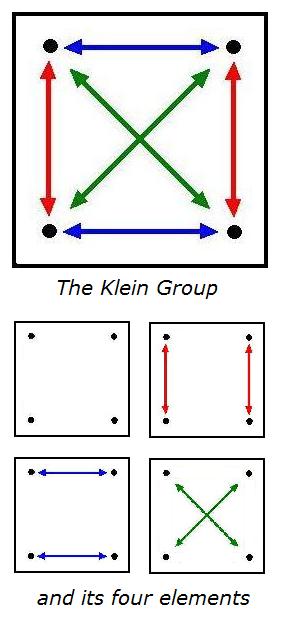
There is also the logical
diamond of opposition —

A semiotic (as opposed to logical)
diamond has been used to illustrate
remarks by Fredric Jameson,
a Marxist literary theorist:
|
"Introduction to Algirdas Greimas, Module on the Semiotic Square," by Dino Felluga at Purdue University–
The semiotic square has proven to be an influential concept not only in narrative theory but in the ideological criticism of Fredric Jameson, who uses the square as "a virtual map of conceptual closure, or better still, of the closure of ideology itself" ("Foreword"* xv). (For more on Jameson, see the [Purdue University] Jameson module on ideology.) Greimas' schema is useful since it illustrates the full complexity of any given semantic term (seme). Greimas points out that any given seme entails its opposite or "contrary." "Life" (s1) for example is understood in relation to its contrary, "death" (s2). Rather than rest at this simple binary opposition (S), however, Greimas points out that the opposition, "life" and "death," suggests what Greimas terms a contradictory pair (-S), i.e., "not-life" (-s1) and "not-death" (-s2). We would therefore be left with the following semiotic square (Fig. 1): 
As Jameson explains in the Foreword to Greimas' On Meaning, "-s1 and -s2"—which in this example are taken up by "not-death" and "not-life"—"are the simple negatives of the two dominant terms, but include far more than either: thus 'nonwhite' includes more than 'black,' 'nonmale' more than 'female'" (xiv); in our example, not-life would include more than merely death and not-death more than life.
* Jameson, Fredric. "Foreword." On Meaning: Selected Writings in Semiotic Theory. By Algirdas Greimas. Trans. Paul J. Perron and Frank H. Collins. Minneapolis: U of Minnesota P, 1976.
|
— The Gameplayers of Zan, by M.A. Foster
"For every kind of vampire,
there is a kind of cross."
— Thomas Pynchon,
Gravity's Rainbow
Crosses used by semioticians
to baffle their opponents
are illustrated above.
Some other kinds of crosses,
and another kind of opponent:
|
Monday, July 11, 2005
Logos
for St. Benedict's Day Click on either of the logos below for religious meditations– on the left, a Jewish meditation from the Conference of Catholic Bishops; on the right, an Aryan meditation from Stormfront.org. Both logos represent different embodiments of the "story theory" of truth, as opposed to the "diamond theory" of truth. Both logos claim, in their own ways, to represent the eternal Logos of the Christian religion. I personally prefer the "diamond theory" of truth, represented by the logo below.
See also the previous entry Sunday, July 10, 2005
Mathematics
and Narrative Click on the title for a narrative about
Nikolaos K. Artemiadis,

"First of all, I'd like to
— Remark attributed to Plato
|
||||||||
Tuesday, March 3, 2009
Tuesday March 3, 2009
there is a kind of cross.”
— Thomas Pynchon in
Gravity’s Rainbow
This entry is continued
from yesterday evening,
from midnight last night,
and from an entry of
February 20 (the date
four years ago of
Hunter Thompson’s death)–
“Emblematizing the Modern“–
|
Emblematizing the Modern
Note that in applications, the vertical axis of the Cross of Descartes often symbolizes the timeless (money, temperature, etc.) while the horizontal axis often symbolizes time. T.S. Eliot:
|
The best villains are the ones who are
both protagonist and antagonist.”
— The late Robert Quarry
“Selah.”
— The late Hunter Thompson

Yesterday afternoon’s online
New York Times:

Today’s online New York Times:
Footnote

Friday, February 20, 2009
Friday February 20, 2009

"For every kind of vampire,
there is a kind of cross."
— Thomas Pynchon in
Gravity's Rainbow
Related material:
A memorial service
held at 2 PM today at the
U.S. Space & Rocket Center
in Huntsville, Alabama, and
today's previous entry.
Tuesday, February 3, 2009
Tuesday February 3, 2009
"I know what 'nothing' means…."
— Joan Didion, Play It As It Lays, Farrar, Straus and Giroux, 1990 paperback, page 214
"In 1935, near the end of a long affectionate letter to his son George in America, James Joyce wrote: 'Here I conclude. My eyes are tired. For over half a century they have gazed into nullity, where they have found a lovely nothing.'"
— Lionel Trilling, "James Joyce in His Letters," Commentary, 45, no. 2 (Feb. 1968), abstract
"The quotation is from The Letters of James Joyce, Volume III, ed. Richard Ellman (New York, 1966), p. 359. The original Italian reads 'Adesso termino. Ho gli occhi stanchi. Da più di mezzo secolo scrutano nel nulla dove hanno trovato un bellissimo niente.'"
— Lionel Trilling: Criticism and Politics, by William M. Chace, Stanford U. Press, 1980, page 198, Note 4 to Chapter 9
"Space: what you damn well have to see."
— James Joyce, Ulysses
"What happens to the concepts of space and direction if all the matter in the universe is removed save a small finite number of particles?"
— "On the Origins of Twistor Theory," by Roger Penrose
"… we can look to the prairie, the darkening sky, the birthing of a funnel-cloud to see in its vortex the fundamental structure of everything…"
— Against the Day, by Thomas Pynchon (See previous entry.)
"A strange thing then happened."
Monday, February 2, 2009
Monday February 2, 2009
Against the Day
is a novel by Thomas Pynchon
published on Nov. 21, 2006, in
hardcover, and in paperback on
Oct. 30, 2007 (Devil's Night).
Perhaps the day the title
refers to is one of the above
dates… or perhaps it is–

|
The Candlebrow Conference in Pynchon's Against the Day: The conferees had gathered here from all around the world…. Their spirits all one way or another invested in, invested by, the siegecraft of Time and its mysteries. "Fact is, our system of so-called linear time is based on a circular or, if you like, periodic phenomenon– the earth's own spin. Everything spins, up to and including, probably, the whole universe. So we can look to the prairie, the darkening sky, the birthing of a funnel-cloud to see in its vortex the fundamental structure of everything–" "Um, Professor–"…. … Those in attendance, some at quite high speed, had begun to disperse, the briefest of glances at the sky sufficing to explain why. As if the professor had lectured it into being, there now swung from the swollen and light-pulsing clouds to the west a classic prairie "twister"…. … In the storm cellar, over semiliquid coffee and farmhouse crullers left from the last twister, they got back to the topic of periodic functions…. "Eternal Return, just to begin with. If we may construct such functions in the abstract, then so must it be possible to construct more secular, more physical expressions." "Build a time machine." "Not the way I would have put it, but if you like, fine." Vectorists and Quaternionists in attendance reminded everybody of the function they had recently worked up…. "We thus enter the whirlwind. It becomes the very essence of a refashioned life, providing the axes to which everything will be referred. Time no long 'passes,' with a linear velocity, but 'returns,' with an angular one…. We are returned to ourselves eternally, or, if you like, timelessly." "Born again!" exclaimed a Christer in the gathering, as if suddenly enlightened. Above, the devastation had begun. |
Wednesday, January 21, 2009
Wednesday January 21, 2009

“… while some are elected,
others not elect are
passed by….”
— A commentary on the
Calvinist doctrine of preterition
| Gravity’s Rainbow, Penguin Classics, 1995, page 742:
“… knowing his Tarot, we would expect to look among the Humility, among the gray and preterite souls, to look for him adrift in the hostile light of the sky, the darkness of the sea…. Now there’s only a long cat’s-eye of bleak sunset left over the plain tonight, bright gray against a purple ceiling of clouds, with an iris of 742″ |
“God is the original
conspiracy theory.”
“We remain a young nation, but in the words of Scripture, the time has come to set aside childish things.”
— President Obama yesterday
It is not entirely clear what these “childish things” are. Perhaps the young nation’s “childish things” that the new President refers to are part of what Robert Stone memorably called “our secret culture.” Stone was referring to Puritanism, which some advocates of the new religion of Scientism might call “childish.” I do not. Lunatic, perhaps, but not childish.
Related meditations:
A year ago yesterday, on Sunday, Jan. 20, 2008, the mid-day lottery for New York State was 605.
A midrash in the Judeo-Christian tradition of paranoia a year ago today suggested that 605 might be a veiled reference to “God, the Devil, and a Bridge,” a weblog entry on mathematician André Weil.
Continuing in this vein a year later, we are confronted with the mid-day New York lottery for yesterday:
Taking a hint from another
entry on Weil, this may be
regarded as a reference to
The Oxford Book of
English Verse (1919 edition):
Selection 742 in that book
comports well with this
jounal’s recent meditations
on death and Brooklyn:
| “Let me glide noiselessly forth; | |
| With the key of softness unlock the locks….” — Walt Whitman |
Applying this method of
exegesis to last year’s
lottery, we have
| “And all that did then attend and follow, |
|
| Were silent with love, as you now, Apollo, |
|
| With envy of my sweet pipings.” |
— Pan: God of Shepherds, Flocks, and Fornication
Hymn 605 thus supplies a reference to the devil mentioned by Weil in the entry of 6/05.
“… thus far, I have not heard any priests of Apollo, nor of any other God, issuing any auguries.”
Neither have I, but hearing is only one of the senses.
“Heard melodies are sweet,
but those unheard
Are sweeter.”— John Keats
Friday, November 14, 2008
Friday November 14, 2008
From a review of José Saramago‘s new novel, Death With Interruptions:
“The church has never been asked to explain anything,” the cardinal assures the prime minister. “Our specialty, along with ballistics, has always been the neutralization of the overly curious mind through faith.”
Related material:
Sept. 7, 2006- Birthday of Elizabeth I
Sept. 7, 2007- Madeleine L’Engle is Dead
Sept. 7, 2008- From the Finland Station
For some mythology relevant to the first two of these three dates, see “Damnation Morning” and The Big Time. For some non-mythology related to ballistics, faith, and the third of these dates, see Rudy Ratzinger vs. Joseph Ratzinger.
of Saramago’s novel…
| “V. is whatever lights you to the end of the street: she is also the dark annihilation waiting at the end of the street.” — Tony Tanner, page 36, Happy birthday,
Olga Kurylenko. |
Monday, June 9, 2008
Monday June 9, 2008
Readers of the previous entry
who wish to practice their pardes
may contemplate the following:

The evening 563 may, as in other recent entries, be interpreted as a page number in Gravity’s Rainbow (Penguin Classics, 1995). From that page:
‘What’s it mean?’
[….]
Slothrop gives him the mandala. He hopes it will work like the mantra that Enzian told him once, mba-kayere (I am passed over), mba-kayere… a spell […]. A mezuzah. Safe passage through a bad night….”
Christ and the Four Elements
This 1495 image is found in
The Janus Faces of Genius:
The Role of Alchemy
in Newton’s Thought,
by B. J. T. Dobbs,
Cambridge University Press,
2002, p. 85
Related mandalas:
and
For further details,
click on any of the
three mandalas above.
“For every kind of vampire,
there is a kind of cross.”
— Thomas Pynchon, quoted
here on 9/13, 2007
Time of entry: 10:20:55 PM
Sunday, June 8, 2008
Tuesday, June 3, 2008
Tuesday June 3, 2008
and The New Yorker
On Faith:
Among the varieties of Christian monotheism, none is more totalitarian, none lodges more radical claims for God's omnipotence, than Calvinism– and within America, the chief analogue of Calvinist theology, Puritanism. According to Calvin every particle of dust, every act, every thought, every creature is governed by the will of God, and yields clues to the divine plan."
On Doubt:
"a Puritan reflex of seeking other orders beyond the visible, also known as paranoia"
— Thomas Pynchon, Gravity's Rainbow (Penguin Classics, 1995), p. 188
On Art:
I suggest that faith and doubt are best reconciled by art– as in A Contrapuntal Theme and in the magazine's current online podcast of Mary Gaitskill reading a 1948 New Yorker story by Vladimir Nabokov.
For the text of the story, see "Signs and Symbols." For an excellent discussion of Nabokov's art, see "The Signs and Symbols in Nabokov's 'Signs and Symbols,'" by Alexander Dolinin.
Sunday, June 1, 2008
Sunday June 1, 2008
Cartoon Graveyard
The conclusion of yesterday’s commentary on the May 30-31 Pennsylvania Lottery numbers:
Thomas Pynchon, Gravity’s Rainbow:
“The fear balloons again inside his brain. It will not be kept down with a simple Fuck You…. A smell, a forbidden room, at the bottom edge of his memory. He can’t see it, can’t make it out. Doesn’t want to. It is allied with the Worst Thing.
He knows what the smell has to be: though according to these papers it would have been too early for it, though he has never come across any of the stuff among the daytime coordinates of his life, still, down here, back here in the warm dark, among early shapes where the clocks and calendars don’t mean too much, he knows that’s what haunting him now will prove to be the smell of Imipolex G.
Then there’s this recent dream he is afraid of having again. He was in his old room, back home. A summer afternoon of lilacs and bees and
286”
What are we to make of this enigmatic 286? (No fair peeking at page 287.)
One possible meaning, given The Archivist‘s claim that “existence is infinitely cross-referenced”–
Page 286 of Ernest G. Schachtel, Metamorphosis: On the Conflict of Human Development and the Psychology of Creativity (first published in 1959), Hillsdale NJ and London, The Analytic Press, 2001 (chapter– “On Memory and Childhood Amnesia”):
“Both Freud and Proust speak of the autobiographical [my italics] memory, and it is only with regard to this memory that the striking phenomenon of childhood amnesia and the less obvious difficulty of recovering any past experience may be observed.”
The concluding “summer afternoon of lilacs and bees” suggests that 286 may also be a chance allusion to the golden afternoon of Disney’s Alice in Wonderland. (Cf. St. Sarah’s Day, 2008)
Some may find the Disney afternoon charming; others may see it as yet another of Paul Simon’s dreaded cartoon graveyards.
More tastefully, there is poem 286 in the 1919 Oxford Book of English Verse– “Love.”
For a midrash on this poem, see Simone Weil, who became acquainted with the poem by chance:
“I always prefer saying chance rather than Providence.”
— Simone Weil, letter of about May 15, 1942
Weil’s brother André might prefer Providence (source of the Bulletin of the American Mathematical Society.)
 (Photo from Providence)
(Photo from Providence)
White, Geometric, and Eternal—

For more on the mathematical significance of this figure, see (for instance) Happy Birthday, Hassler Whitney, and Combinatorics of Coxeter Groups, by Anders Björner and Francesco Brenti, Graduate Texts in Mathematics, vol. 231, Springer, New York, 2005.
This book is reviewed in the current issue (July 2008) of the above-mentioned Providence Bulletin.
The review in the Bulletin discusses reflection groups in continuous spaces.
the phrase “as a little child.”
Friday, December 29, 2006
Friday December 29, 2006
of Christ Church
"For every kind of vampire,
there is a kind of cross."
— Thomas Pynchon
Click on picture for details.
Today is the feast
of St. Thomas Becket.
In his honor, a meditation
on tools and causation:
— Review by H. Allen Orr in
The New York Review of Books,
Vol. 54, No. 1, January 11, 2007
"An odd extension"–
Wolpert's title is, of course,
from Lewis Carroll.
Related material:
"It's a poor sort of memory
that only works backwards."
— Through the Looking-Glass
An event at the Kennedy Center
broadcast on
December 26, 2006
(St. Steven's Day):
from the conclusion to
(Log24, Aug. 22, 2005):
"At times, bullshit can
only be countered
with superior bullshit."
— Norman Mailer
"The concept of possible worlds dates back to at least Leibniz who in his Théodicée tries to justify the apparent imperfections of the world by claiming that it is optimal among all possible worlds. Voltaire satirized this view in his picaresque novel Candide….
Borges' seminal short story El jardín de senderos que se bifurcan ("The Garden of Forking Paths") is an early example of many worlds in fiction."
"Il faut cultiver notre jardin."
— Voltaire
"We symbolize
logical necessity
with the box ![]() )
)
and logical possibility
with the diamond ![]() )."
)."
"The possibilia that exist,
and out of which
the Universe arose,
are located in
a necessary being…."
— Michael Sudduth,
Notes on
God, Chance, and Necessity
by Keith Ward,
Regius Professor of Divinity,
Christ Church College, Oxford
(the home of Lewis Carroll)
For further details,
click on the
Christ Church diamond.
Wednesday, December 20, 2006
Wednesday December 20, 2006
"For every kind of vampire,
there is a kind of cross."
— Thomas Pynchon

"Also on the card is Adrien Brody ('The Thin Red Line') as a poseur proto-punk who lives in his parents' converted garage and strips at an underground gay club. He takes heat from his former friends– the aforementioned neighborhood toughs– for affecting an English accent and wearing a mohawk…."
— Rob Blackwelder review of Spike Lee's "Summer of Sam" (1999)

"With its white community focus, Summer of Sam is something of a departure for Lee. But with its immaculate script, faultless acting and Lee's own cameo performance, it is a typical Spike Lee film. Plenty of rapid-fire, wise-cracking dialogue and hectic crowd scenes make it fraught with tension from beginning to end. Hectic, inventive, gritty, witty, edgy and provocative, no detail is too small to escape Lee's attention and no issue too large as the film's perceptive dissection of human nature moves effortlessly between humour and horror."

"At another end of the sexual confusion spectrum, there's Vinny's childhood friend, now turned spiky-haired punk rocker, Ritchie (Adrien Brody). Recently he's started dating Ruby (Jennifer Esposito), erstwhile neighborhood tramp. They are both redeemed by their relationship, which at least at first, involves no sex, technically. Where Vinny struggles with his culturally instilled madonna-whore complex, Ritchie's just back from a stint living in the Village, looking for an identity that's distinct from his Italian gotta-be-macho upbringing. Eventually, he gets a gig at CBGB's ('How do you spell that?' wonders Vinny), but in order to make ends meet (and pay for his new guitar), he's dancing and turning tricks at Male World, a decrepit gay club where he performs fellatio with a life-sized dummy on stage, and, you assume, with clients offscreen."
— Cynthia Fuchs revew (title: "Sex and the City")
Susan G. Cole on the
75th Annual Academy Awards,
presented March 23, 2003 —
"I watched Halle Berry wipe her mouth off after Adrien Brody, in the heat of his excitement, laid the lip-lock on her for five full excruciating seconds. She was stunned, and seemed to have no idea what had happened to her. I'll tell you what happened, Halle: it's called sexual assault."

The Kiss…

Where's the Oscar
for the mouth-wipe?
Sunday, November 26, 2006
Sunday November 26, 2006
Rosalind Krauss
in "Grids," 1979:
"If we open any tract– Plastic Art and Pure Plastic Art or The Non-Objective World, for instance– we will find that Mondrian and Malevich are not discussing canvas or pigment or graphite or any other form of matter. They are talking about Being or Mind or Spirit. From their point of view, the grid is a staircase to the Universal, and they are not interested in what happens below in the Concrete.
Or, to take a more up-to-date example…."
"He was looking at
the nine engravings
and at the circle,
checking strange
correspondences
between them."
— The Club Dumas,1993
"And it's whispered that soon
if we all call the tune
Then the piper will lead us
to reason."
— Robert Plant,1971
The nine engravings of
The Club Dumas
(filmed as "The Ninth Gate")
are perhaps more an example
of the concrete than of the
universal.
An example of the universal*–
or, according to Krauss, a
"staircase" to the universal–
is the ninefold square:

"This is the garden of Apollo,
the field of Reason…."
— John Outram, architect
For more on the field
of reason, see
Log24, Oct. 9, 2006.
A reasonable set of
"strange correspondences"
in the garden of Apollo
has been provided by Ezra Brown
in a mathematical essay (pdf).
Unreason is, of course,
more popular.
* The ninefold square is perhaps a "concrete universal" in the sense of Hegel:
"Two determinations found in all philosophy are the concretion of the Idea and the presence of the spirit in the same; my content must at the same time be something concrete, present. This concrete was termed Reason, and for it the more noble of those men contended with the greatest enthusiasm and warmth. Thought was raised like a standard among the nations, liberty of conviction and of conscience in me. They said to mankind, 'In this sign thou shalt conquer,' for they had before their eyes what had been done in the name of the cross alone, what had been made a matter of faith and law and religion– they saw how the sign of the cross had been degraded."
— Hegel, Lectures on the History of Philosophy, "Idea of a Concrete Universal Unity"
"For every kind of vampire,
there is a kind of cross."
— Thomas Pynchon
Sunday November 26, 2006

Related material from March 2004:
Anschaulichkeit (3/16) and
Readings for St. Patrick’s Day.
“For every kind of vampire,
there is a kind of cross.”
— Thomas Pynchon,
Gravity’s Rainbow
Monday, July 24, 2006
Monday July 24, 2006

Tom Stoppard and an ad for a concert
in Pribor, Czech Republic,
birthplace of Sigmund Freud
Related material:
and the five Log24 entries
ending on this date last year.
By Syd Barrett,
Dead Poet:
— From the 1967 album
“The Piper at the Gates of Dawn“
Thursday, July 13, 2006
Thursday July 13, 2006
By Syd Barrett,
Dead Poet
— From the 1967 album
“The Piper at the Gates of Dawn“
Monday, May 22, 2006
Monday May 22, 2006
Google Maps image
of the isle of Delos,
birthplace of Apollo:

“I faced myself that day with
the nonplused apprehension
of someone who has
come across a vampire
and has no crucifix in hand.”
— Joan Didion, “On Self-Respect,”
in Slouching Towards Bethlehem
“For every kind of vampire,
there is a kind of cross.”
— Thomas Pynchon,
Gravity’s Rainbow

Related material:
Thursday, April 27, 2006
Thursday April 27, 2006
From today’s online
Harvard Crimson:

From an Amazon.com review
of McCafferty’s latest book:
which quotes Thomas Pynchon —
there is a kind of cross.”
— Gravity’s Rainbow
— and an entry of April 8
that contains the following
“kind of cross” —
3 PM
Good
Friday

Wednesday, April 26, 2006
Wednesday April 26, 2006
“‘Lestat,’ the maiden Broadway production of Warner Brothers Theater Ventures, is the third vampire musical to open in the last few years, and it seems unlikely to break the solemn curse that has plagued the genre. Directed by Robert Jess Roth from a book by Linda Woolverton, the show admittedly has higher aspirations and (marginally) higher production values than the kitschy ‘Dance of the Vampires’ (2002) and the leaden ‘Dracula: The Musical’ (2004), both major-league flops.” — Ben Brantley
See Log24,
St. Patrick’s Day 2004:
“I faced myself that day with
the nonplused apprehension
of someone who has
come across a vampire
and has no crucifix in hand.”
— Joan Didion, “On Self-Respect,”
in Slouching Towards Bethlehem
“For every kind of vampire,
there is a kind of cross.”
— Thomas Pynchon,
Gravity’s Rainbow

See also
Monday, April 17, 2006
Monday April 17, 2006
Sub Specie Aeternitatis
"Pynchon's mind is the steel trap
of American literature."
— Lorrie Moore, from
a page linked to in
"Eternal," an entry
of April 12
Related material:
Wednesday, April 12, 2006
Wednesday April 12, 2006
Eternal
Franklin Delano Roosevelt:
“Eternal truths will be neither true nor eternal unless they have fresh meaning for every new social situation.”
— AP, Today in History,
apparently quoted from an address
at the University of Pennsylvania,
Sept. 20, 1940
Related material:
Gravity’s Rainbow, the beginning of page 373*:
“white and geometric capital before the destruction”
Gravity’s Rainbow, the end of page 373*:
“Slothrop was going into high school when FDR was starting out in the White House. Broderick Slothrop professed to hate the man, but young Tyrone thought he was brave.”
for Dec. 20, 2003 —
White, Geometric, and Eternal —
and the entry for 8 PM on
the feast of St. John Paul II —
Miracle, April 2, 2006.
Saturday, December 10, 2005
Saturday December 10, 2005
Roger Shattuck, Scholar, Is Dead at 82
In his honor, some excerpts from previous entries:
I just subscribed to The New York Review of Books online for another year,
prompted by my desire to read Roger Shattuck on Rimbaud….
"How did this poetic sensibility come to burn so bright?"
The Shattuck piece is from 1967, the year of The Doors' first album.
(See Death and the Spirit, Part II.)

|
The photo of Nicole Kidman
is from Globe Song
(Log24, Jan. 18, 2005).
The Times says Shattuck died
on Thursday (Dec. 8, 2005).
Here, from 4:00 AM on the
morning of Shattuck's death,
is a brief companion-piece
to Eight is a Gate:
|
From Carole A. Holdsworth, Tanner may have stated it best:
“V. is whatever lights you to
(Tony Tanner, page 36,
She's a mystery |
She's in midnight blue,
still the words ring true;
woman in blue
got a hold on you.
Thursday, December 8, 2005
Thursday December 8, 2005
"Death itself would start
working backward."
— Aslan in
The Chronicles of Narnia
"'Memory is non-narrative
and non-linear,'
Lin said of the work….
'People say,
"How do you read this?"
Any way you want.'"
"Work as if you were in the
early days of a better nation."
— God, according to the author of 1982 Janine

From Carole A. Holdsworth, Tanner may have stated it best:
“V. is whatever lights you to
(Tony Tanner, page 36,
She's a mystery |
Tuesday, June 7, 2005
Tuesday June 7, 2005
Too Clever by Half
Prime Minister of France:
“In Praise of Those Who Stole the Fire, M. de Villepin’s grandest literary effort to date…. will enhance his reputation within a small Paris set, but not in Washington, where he is already regarded as too clever by half.”
— Philip Delves Broughton,
“De Villepin bares soul
as France’s politician poet,”
The Telegraph, May 23, 2003
Frankenstein, or The Modern Prometheus:
The Titan Prometheus was “‘… chained to Mount Caucasus where an eagle preyed on his liver’ (Bullfinch [sic] 939).” The study guide does not say whether 939 is a page number or paragraph number, nor does it name which edition of Bulfinch’s Mythology is meant.
“Prometheus — One of the Titans of Greek myth, famous as a benefactor of man. Zeus had him make men out of mud and water; however, pitying mankind, he stole fire from heaven and gave it to them. As punishment, Zeus chained him to Mount Caucasus where an eagle preyed on his liver all day, the liver being renewed at night. Hercules eventually released him and killed the eagle. Zeus sent Pandora to Earth with her box of evils to balance the gift of fire.”
Why 939 signifies
“too clever by half” —
see 6:26 and 313.
See also

| Joke #939 |
|
| Date: Thu, 13 Nov 1997 From: Rainybow |
|
| Q: Do you know why God created woman second? A: Because he didn’t want all the advice. |
|
Wednesday, March 17, 2004
Wednesday March 17, 2004
Readings for
St. Patrick's Day
Books:
Finnegans Wake (1939)
Gravity's Rainbow (1978)
Masks of the Illuminati (1981)
Quotations:
"Nature does not know extinction;
all it knows is transformation.
Everything science has taught me,
and continues to teach me,
strengthens my belief in
the continuity of our
spiritual existence
after death."
— Wernher von Braun
"I faced myself that day
with the nonplused apprehension
of someone who has
come across a vampire
and has no crucifix in hand."
— Joan Didion, "On Self-Respect,"
in Slouching Towards Bethlehem
|
"For every kind of vampire, — Thomas Pynchon, Inscribed
In Latin, NORMA Multa renascentur quae iam cecidere, cadentque Many terms will be born again All, all must perish — but, surviving last, "Norma was the latin word for what we now call a carpenter's square. It was used to construct lines which were at right angles to another line, so the created line was said to be 'normal.' The norma was also used as a standard to compare if objects, like a wall, might be erect (perpendicular to the ground) and so those that met the standard were called 'normal' and this use extended to the 'typical' element of any type of set. Eventually normal came to mean anything that 'met the |
"317 is a prime,
not because we think so,
or because our minds are shaped
in one way rather than another,
but because it is so,
because mathematical reality
is built that way."
— G. H. Hardy,
A Mathematician's Apology
Saturday, December 20, 2003
Saturday December 20, 2003
White, Geometric, and Eternal
This afternoon's surfing:
Prompted by Edward Rothstein's own Fides et Ratio encyclical in today's NY Times, I googled him.
At the New York Review of Books, I came across the following by Rothstein:
"… statements about TNT can be represented within TNT: the formal system can, in a precise way, 'talk' about itself."
This naturally prompted me to check what is on TNT on this, the feast day of St. Emil Artin. At 5 PM this afternoon, we have Al Pacino in "The Devil's Advocate" — a perfect choice for the festival of an alleged saint.
Preparing for Al, I meditated on the mystical significance of the number 373, as explained in Zen and Language Games: the page number 373 in Robert Stone's theological classic A Flag for Sunrise conveys the metaphysical significance of the phrase "diamonds are forever" — "the eternal in the temporal," according to Stone's Catholic priest. This suggests a check of another theological classic, Pynchon's Gravity's Rainbow. Page 373 there begins with the following description of prewar Berlin:
"white and geometric."
This suggests the following illustration of a white and geometric object related to yesterday's entry on Helmut Wielandt:

Figure 1
(This object, which illustrates the phrase "makin' the changes," also occurs in this morning's entry on the death of a jazz musician.)
A further search for books containing "white" and "geometric" at Amazon.com yields the following:

Figure 2
From Mosaics, by
Fassett, Bahouth, and Patterson:
"A risco fountain in Mexico city, begun circa 1740 and made up of Mexican pottery and Chinese porcelain, including Ming.
The delicate oriental patterns on so many different-sized plates and saucers [are] underlined by the bold blue and white geometric tiles at the base."
Note that the tiles are those of Diamond Theory; the geometric object in figure 1 above illustrates a group that plays a central role in that theory.
Finally, the word "risco" (from Casa del Risco) associated with figure 2 above leads us to a rather significant theological site associated with the holy city of Santiago de Compostela:

Figure 3
Vicente Risco's
Dedalus in Compostela.
Figure 3 shows James Joyce (alias Dedalus), whose daughter Lucia inspired the recent entry Jazz on St. Lucia's Day — which in turn is related, by last night's 2:45 entry and by Figure 1, to the mathematics of group theory so well expounded by the putative saint Emil Artin.
"His lectures are best described as
polished diamonds."
— Fine Hall in its Golden Age,
by Gian-Carlo Rota
If Pynchon plays the role of devil's advocate suggested by his creation, in Gravity's Rainbow, of the character Emil Bummer, we may hope that Rota, no longer in time but now in eternity, can be persuaded to play the important role of saint's advocate for his Emil.
Update of 6:30 PM 12/20/03:
Riddled:
The Absolutist Faith
of The New York Times
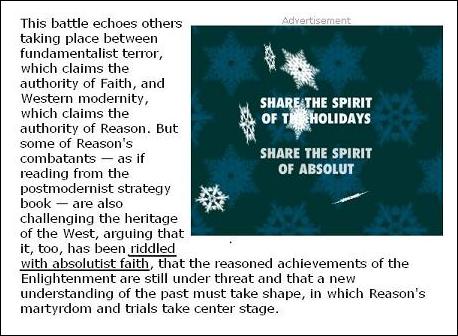
White and Geometric, but not Eternal.
Wednesday, December 18, 2002
Wednesday December 18, 2002
For the Dark Lady
On this midnight in the garden of good and evil, our new site music is “Nica’s Dream.”
From a website on composer Horace Silver:
“Horace Silver apparently composed Nica’s Dream (1956) for Baroness Pannonica de Koenigswarter-Rothschild, an English aristocrat and a very dear friend of his. She was known to the New York press as the Jazz Baroness and to the black musicians for whom she was something of a patron, simply as Nica. Her apartment in the fashionable Hotel Stanhope on Fifth Avenue became a ‘hospitality suite for some of the greatest jazz players of the day, whom she treated generously.’ (Jack Chambers, Milestones: The Music and Times of Miles Davis, University of Toronto Press, 1985, 1:248)
This music is not unrelated to the work of Thomas Pynchon. From an essay by Charles Hollander:
“There are some notable parallels between Nica and the woman Stencil knows as V., who started her career with ‘…a young crude Mata Hari act.’ (V.; 386)…. Not that V. is Nica in any roman a clef sense: she is not. But the resonances are powerful at the level of the subtext. Nica is a Rothschild whose life reflects the issues Pynchon wants us to attend in V.: disinheritance, old dynasty vs. new dynasty, secret agents and couriers, plots and counter-plots, ‘The Big One, the century’s master cabal,’ and ‘the ultimate Plot Which Has No Name’ (V.; 226)….”
See also my journal entry for the December 16-17 midnight, “Just Seventeen.”
Sunday, September 8, 2002
Sunday September 8, 2002
The Maltese
V
Today, September 8, is
The Feast of Our Lady of Victories in Malta.
"The 8th of September festivity is close to Maltese hearts."
"The 8th September is a special public holiday because it commemorates in fact three events. It is the religious feast celebrating the birth of the Holy Virgin, Maria Bambina; it is the day on which the Great Siege of 1565 ended; and it also the day on which the Italian navy capitulated to the British at the beginning of the end of the Second World War.
But is it best known as victory day, il-Vitorja, in commemoration of the events of 1565 when the Knights of St John and the Maltese Islanders defeated the Ottoman Turks and helped rid Christendom of the Saracen threat.
The feast is celebrated in the villages and towns of Senglea, Naxxar, Mellieha and Xaghra on Gozo."
From Malta's Importance in History:
"Malta managed to keep the enemy at bay, and was awarded the George Cross for it in 1942. Churchill, Roosevelt, Eisenhower and other leaders visited Malta during this time. Malta was called 'the under-belly of Europe,' and her insidious disruption of the Kesserling-Rommel axis who tried hard, and very nearly successfully, to starve the native population and render all military operations impossible through the lack of food and fuel. The lifting of the siege coincided with the Feast of our Lady of Victory: 'il-Vitorja', the 'national' feast."
"From about three days before September 8, ground fireworks, Maltese 'giggifogu' (derived from Italian 'guochi di fuoco'), start to light up the Mellieha Parish Square, with amazing effects. The principal show of ground fireworks is held on September 7, a show which ends at about 12.00am.

Fireworks over Mellieha
The D-Day finally arrives. Early in the morning of September 8, many people attend the sermon in honor of Our Lady of Victories."
Today's feast is known to Roman Catholics as The Feast of the Nativity of Our Lady.
See also the novel by Thomas Pynchon, V.
Monday, August 26, 2002
Monday August 26, 2002
Meditation on the Dark Lady:
Doble-V + Doble-V = W.W.



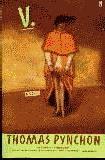
From Carole A. Holdsworth, Dulcinea and Pynchon’s V:
Tanner may have stated it best:
“V. is whatever lights you to the end of the street: she is also the dark annihilation waiting at the end of the street.”
(Tony Tanner, page 36, “V. and V-2.” in Pynchon: A Collection of Critical Essays. Ed. Edward Mendelson. Englewood Cliffs, N. J.: Prentice-Hall, 1978. 16-55).

Monday August 26, 2002
 |
A link for the August 26 birthdays of
Rufino Tamayo and Julio Cortazar:
Homage to Thelonious Sphere Monk.
See also “Sphere” in Pynchon’s V.
